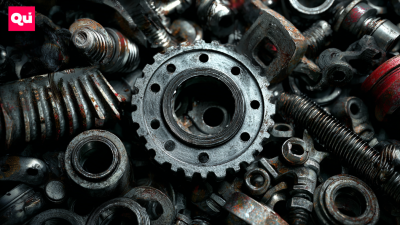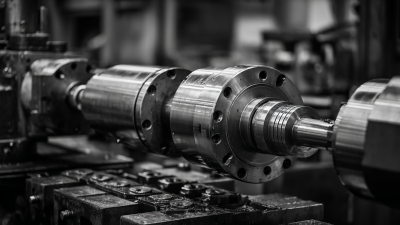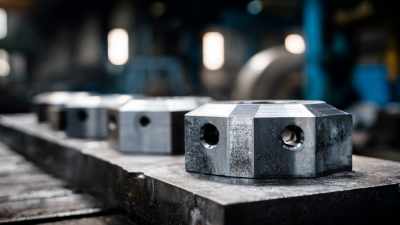Leave Your Message
-
Phone
-
E-mail
The aerospace manufacturing industry is poised for a transformative shift, driven by the adoption of advanced techniques in the production of forged aluminum parts. As the demand for lightweight, durable, and efficient materials increases, forged aluminum parts are emerging as a critical solution in modern aircraft design and construction. These components not only enhance performance and fuel efficiency but also contribute to the overall sustainability of aerospace operations.
In this digital age, manufacturers are leveraging cutting-edge technologies such as advanced simulations, real-time data analytics, and automated processes to optimize the forging process. This innovative approach not only streamlines production but also ensures that the forged aluminum parts meet stringent quality and precision standards essential for aerospace applications.

As we look towards the future, the integration of these advanced manufacturing techniques will redefine the landscape of the aerospace industry, enabling the creation of lighter, stronger, and more efficient aircraft. In this article, we will explore the potential of forged aluminum parts and provide insightful tips on how manufacturers can effectively implement these advanced techniques, ensuring they remain competitive in an ever-evolving market.
The aerospace manufacturing industry has witnessed a significant evolution in the use of forged aluminum parts, driven by advancements in production techniques and material science. Historically, aluminum was favored for its lightweight and corrosion-resistant properties, but recent innovations have expanded its application and performance in aerospace components. According to a report by MarketsandMarkets, the global aerospace aluminum market is expected to reach approximately USD 4.8 billion by 2026, growing at a 5.2% CAGR from 2021 to 2026. This growth is attributed to the increasing demand for fuel-efficient aircraft and the ongoing shift towards more sustainable manufacturing practices.
One of the key advancements in forged aluminum technology is the adoption of superplastic forming and precision forging techniques, which enhance the mechanical properties and structural integrity of components. These methods allow manufacturers to produce complex geometries with minimal waste, improving efficiency and reducing costs. A study by the Aluminum Association highlights that forged aluminum parts can achieve weight savings of up to 30% compared to traditional cast components, which is crucial for achieving better fuel efficiency in aerospace applications.
As the industry continues to innovate, the role of forged aluminum in the production of critical aerospace components will undoubtedly expand, fostering further advancements in aircraft design and performance.
Innovative techniques in forged aluminum production are setting new standards in aerospace manufacturing. The aerospace sector is increasingly adopting advanced forging methods to enhance the strength-to-weight ratio of components, crucial for improving fuel efficiency. According to a report by the Freedonia Group, the global aluminum forging market is projected to reach $7.5 billion by 2027, propelled by advancements in manufacturing technologies. These innovations not only optimize the material properties of aluminum parts but also streamline production processes, reducing lead times significantly.
The integration of additive manufacturing and sophisticated numerical modeling is transforming how aluminum components are designed and produced. Techniques such as hot forging and isothermal forging enable manufacturers to create intricate designs while maintaining structural integrity. Additionally, the use of artificial intelligence in predictive maintenance and quality control is expected to further enhance the efficiency and reliability of forged aluminum production. A research study published by MarketsandMarkets indicates that the aerospace sector's demand for forged aluminum components is anticipated to grow at a CAGR of 4.3% from 2022 to 2027, highlighting the industry's shift toward more efficient and innovative manufacturing practices.
Forged aluminum parts are transforming aircraft design, offering several key benefits that enhance performance and efficiency. One significant advantage is their
superior strength-to-weight ratio, which is crucial in aerospace applications. According to a report by the Aircraft Fleet Recycling Association,
using forged aluminum can reduce aircraft weight by up to 10%, leading to fuel savings and improved aerodynamics. This attribute aligns perfectly with the industry's ongoing focus on
sustainability and operational efficiency.
Moreover, forged aluminum components demonstrate exceptional fatigue resistance compared to their cast counterparts. This durability is essential for aircraft that endure
rigorous flight conditions. A study from the American Society for Testing and Materials indicates that forged aluminum parts can withstand higher cyclical loads, contributing to
longer service intervals and lower maintenance costs. Enhanced reliability is becoming a critical factor as airlines look to reduce operational downtime and improve safety.
Tip: When considering the incorporation of forged aluminum parts, assess supplier certifications and production capabilities to ensure quality and compliance with industry standards.
Also, keep an eye on advancements in forging technology that may offer further advantages in terms of cost and performance efficiency.
The aerospace sector faces significant challenges in the adoption of forged aluminum parts, particularly as it demands high performance standards for safety and efficiency. As outlined in recent industry reports, the North America forging market is projected to experience continuous growth, driven by the increasing need for advanced materials in defense and aerospace applications. The reports indicate that high-strength aluminum alloys are gaining traction due to their favorable weight-to-strength ratio, essential for flight effectiveness.
One critical area of focus is the production of seamless rolled rings, which are vital components in jet engines and landing gear. Recent innovations in forging techniques aim to reduce production costs while enhancing material properties. For instance, companies are leveraging advanced induction billet forge furnaces that drastically improve the heating process, making it more energy-efficient and suitable for complex part geometries. Moreover, the integration of AI and digital sustainment practices is positioned to revolutionize quality control and reduce waste, contributing to a more sustainable manufacturing process in aluminum aerospace applications. This shift towards advanced methodologies not only meets the growing demand for lightweight yet robust aircraft components but also aligns with environmental sustainability initiatives in the industry.
The aerospace manufacturing industry is witnessing a significant transformation driven by advancements in forged aluminum technologies. As the global forged aluminum market is projected to reach an impressive $137.4 billion by 2033, growing at a compound annual growth rate (CAGR) of 5.3% from an estimated $90.9 billion in 2025, the demand for lightweight, high-strength materials continues to rise. This trend is particularly influential in aviation, where reducing weight and enhancing fuel efficiency are paramount for both operational cost and environmental sustainability.
In the context of new materials, the evolution of forging techniques heralds the emergence of superior aluminum alloys that offer enhanced performance characteristics catering to the stringent requirements of modern aircraft. Advanced methods such as precision forging and additive manufacturing are unlocking new possibilities for design and production efficiency. Moreover, reports indicate a notable increase in domestic production capabilities in high-end aluminum processing, marking a transition from reliance on lower-tier products to the development of self-sufficient, advanced metallurgical solutions. This shift is essential as industries aim to optimize material utilization while maintaining safety and performance standards in aerospace applications.






